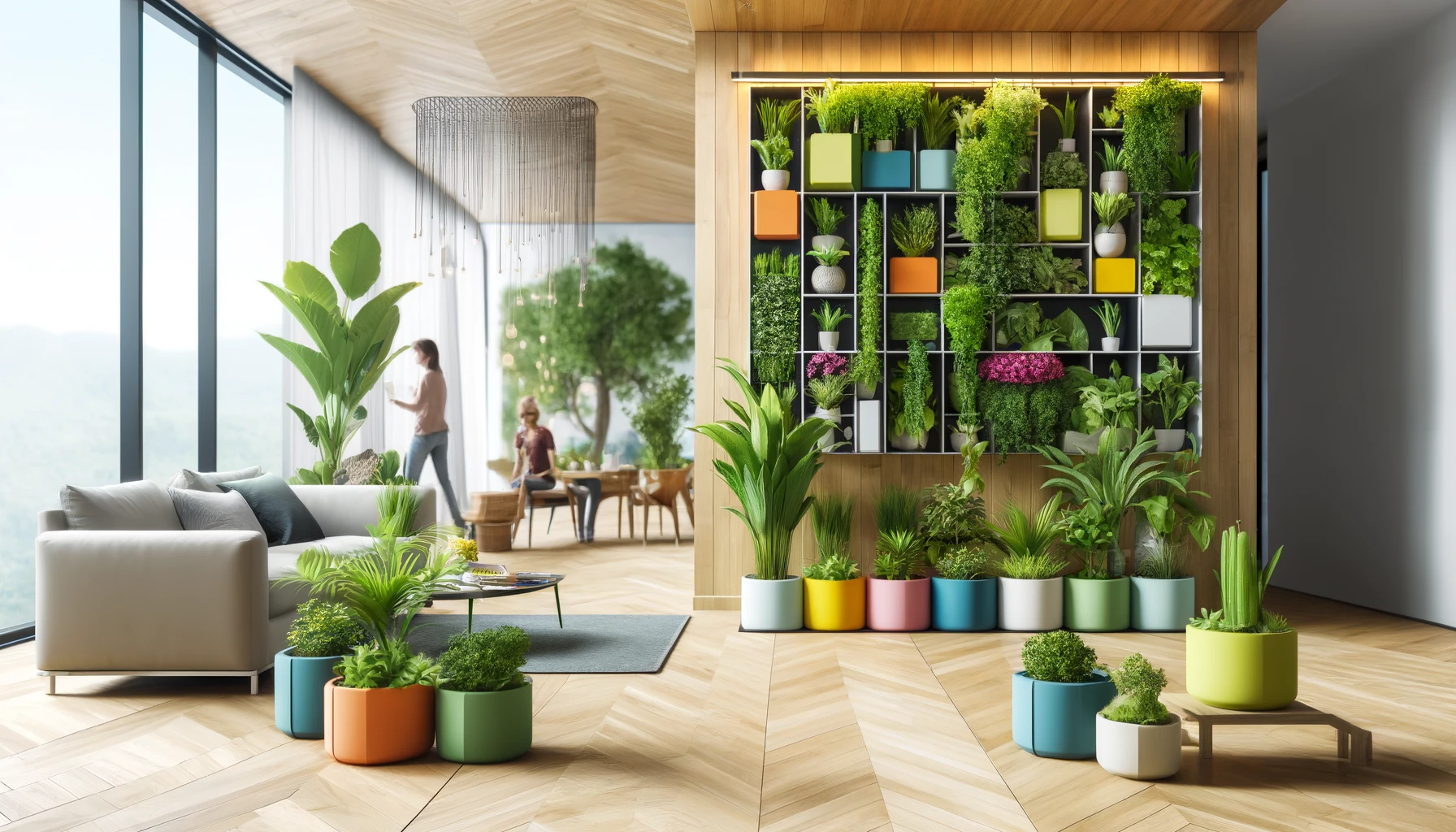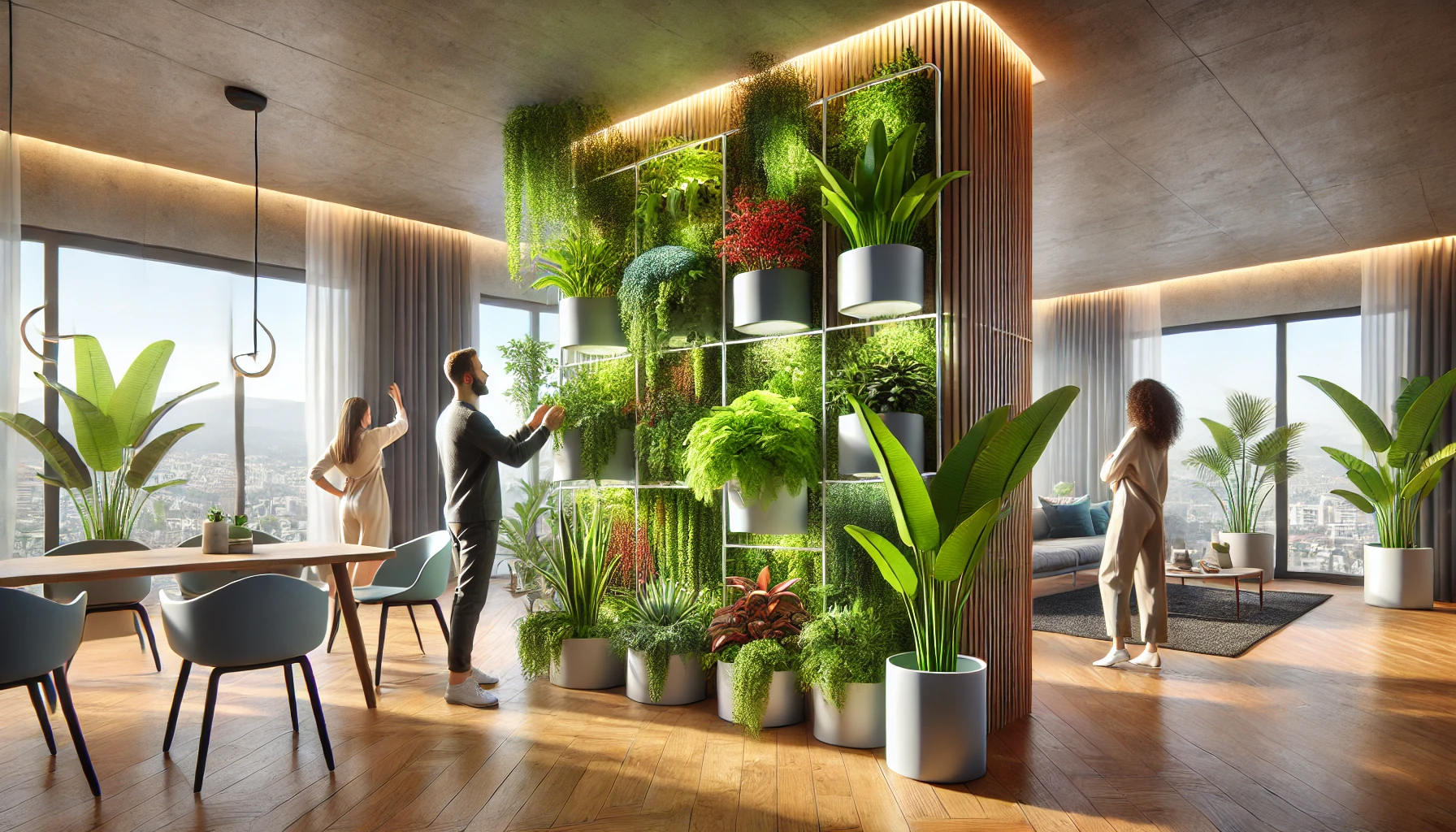Indoor vertical garden planters are revolutionizing the way we bring nature into our homes. With urban living spaces becoming increasingly compact, these innovative solutions offer a fresh approach to incorporating greenery in a stylish and functional manner.
In this comprehensive guide, we’ll explore the rising trend of indoor vertical garden planters, their benefits, and practical ways to set them up in your home.
Why Indoor Vertical Garden Planters Are Becoming a Trend
The surge in popularity of indoor vertical garden planters can be attributed to several factors. Firstly, the global shift towards eco-friendly lifestyles has inspired many to seek sustainable ways of enhancing their living spaces.
Vertical gardens serve as a space-saving solution that caters to the urban dweller’s need for greenery. Additionally, the aesthetic appeal of vertical gardens makes them a favored choice among interior designers looking to merge natural elements with modern decor.
The Benefits of Integrating Nature Within Indoor Spaces
Bringing nature indoors has proven psychological and physical health benefits. Indoor vertical garden planters not only purify the air by filtering toxins but also reduce stress and boost creativity.
They create a calming environment, improve humidity levels, and provide a visually pleasing focal point within any room. Whether in a living room, office, or kitchen, these planters enhance overall well-being while adding a touch of elegance.
Exploring Large Indoor Vertical Garden Planters
Large indoor vertical garden planters take indoor gardening to a whole new level. Let’s delve into their unique advantages and the creative design options they offer.
Advantages of Large Indoor Planters in Small Spaces
Contrary to popular belief, large planters can be a great addition to small spaces. They utilize vertical areas that would otherwise remain unused, maximizing functionality without crowding the room.
By growing plants upwards rather than outwards, these planters allow for a lush, green atmosphere even in the smallest apartments.
Design Varieties Suitable for Different Interiors
Large indoor vertical garden planters come in a variety of designs to suit diverse interior styles. From minimalist wooden frames to sleek metal structures and colorful plastic modules, there’s something for everyone.
Homeowners can choose designs that blend seamlessly with their decor or opt for bold statement pieces that draw attention.
Balancing Aesthetics and Functionality in Large Planters
A successful indoor vertical garden strikes the perfect balance between aesthetics and functionality. Large planters can house a wide range of plant types, including flowering species, herbs, and ferns.
Careful arrangement ensures visual appeal while maintaining easy access for watering and maintenance.
Understanding Indoor Vertical Garden Hydroponics
Hydroponic systems are increasingly being integrated into indoor vertical gardens, offering a soil-free, efficient method of growing plants.
Introduction to Hydroponic Techniques for Indoor Gardens
Hydroponics involves growing plants using nutrient-rich water instead of soil. This innovative technique is particularly suited for vertical gardens, where soil management can be challenging. It allows for precise control of nutrients, leading to healthier and faster-growing plants.
Benefits of Hydroponics Over Traditional Soil Gardens
Hydroponic systems offer several advantages over traditional soil gardening. They use up to 90% less water, require less space, and virtually eliminate the risk of soil-borne pests and diseases.
Additionally, hydroponic gardens often yield higher productivity, making them ideal for urban gardeners looking to grow fresh produce at home.
Adopting Hydroponic Systems that Suit Vertical Structures
When setting up a hydroponic vertical garden, it’s important to choose systems that align with the planter’s structure. Options such as nutrient film technique (NFT), drip systems, and aeroponics are commonly used. Each has its own benefits, depending on the type of plants and the available space.
Choosing the Best Indoor Vertical Garden Planters
Selecting the right planter is crucial for creating a thriving indoor vertical garden. Here’s a guide to help you make an informed decision.
Factors to Consider When Choosing a Planter
When choosing an indoor vertical garden planter, consider factors such as size, material, drainage, and ease of maintenance.
Ensure the planter fits your space and accommodates the type of plants you want to grow. Good drainage is essential to prevent root rot, and maintenance requirements should match your lifestyle.
Material Matters: Wood, Metal, Plastic, and Beyond
Planters come in various materials, each with its own pros and cons. Wooden planters offer a rustic charm but may require waterproofing.
Metal planters are durable and modern but can be heavy. Plastic planters are lightweight and versatile but may not have the same aesthetic appeal. Consider your needs and preferences when selecting materials.
Top-Rated Planters Available in Today’s Market
From modular systems to wall-mounted options, there are countless planters to choose from. Some top-rated brands include WallyGro, Urbio, and MyGift. These offer durability, easy installation, and stylish designs to suit various tastes.
Locating Indoor Vertical Garden Planters for Sale
Finding the perfect indoor vertical garden planter is easier than ever, thanks to a variety of purchasing options.
Where to Buy: From Local Nurseries to Online Stores
Local nurseries often carry a selection of indoor vertical garden planters, and their staff can provide valuable advice on plant care. Online stores like Amazon, Etsy, and Wayfair offer a vast array of designs and materials, making it easy to compare prices and read customer reviews.
Tips for Online Shopping: Ensuring Quality Before Purchase
When shopping online, ensure quality by reading product descriptions carefully and checking customer ratings. Look for detailed photos and verify dimensions to avoid surprises. Reputable sellers will often provide guarantees or return policies for added peace of mind.
Leveraging Local Artisan Markets for Unique Planters
For those seeking unique, handcrafted designs, local artisan markets are a treasure trove. These markets often feature bespoke planters made from reclaimed materials, offering a personal touch that mass-produced options can’t match.
Setting Up an Indoor Vertical Wall Planter
Creating a stunning vertical wall planter is simpler than you might think. Here’s a step-by-step guide to get you started.
Step-by-Step Guide to Installing a Planter Wall
- Choose a suitable wall and measure the available space.
- Select a sturdy wall-mountable planter system.
- Install brackets or mounting hardware as instructed.
- Arrange plants in their designated slots, ensuring proper spacing.
- Water and monitor the plants regularly to ensure healthy growth.

Using an Indoor Vertical Wall Planter to Enhance Interior Aesthetics
A vertical wall planter serves as a living artwork, transforming any room into a green oasis. By mixing different plant textures and colors, you can create eye-catching patterns that complement your interior design.
Maintaining and Caring for Your Vertical Wall Garden
Regular maintenance is key to a thriving vertical garden. Check for signs of pests, prune as needed, and ensure adequate lighting. Consistent watering and occasional nutrient supplementation will keep your plants healthy and vibrant.
The Perks of Indoor Wall Gardens with Grow Lights
Grow lights play an essential role in indoor gardening, especially in spaces with limited natural light.
The Role of Grow Lights in Indoor Gardening
Grow lights mimic natural sunlight, providing the spectrum of light that plants need for photosynthesis. They’re particularly beneficial for indoor vertical gardens, where natural light might not reach all sections evenly.
How to Install and Optimize Grow Light Usage
Position grow lights about 6-12 inches above the plants and adjust the height as they grow. Use timers to ensure plants receive 12-16 hours of light daily, depending on their specific needs. Avoid excessive exposure, as it may cause leaf burn.
Choosing the Right Type of Light for Different Plant Types
Different plants require different light spectrums. For example, leafy greens thrive under blue light, while flowering plants benefit from red light. Full-spectrum LED grow lights are a versatile choice, catering to a variety of plants.
Innovative Approaches to Vertical Wall Planters Outdoor
Outdoor vertical planters offer endless possibilities for enhancing your landscape.
Blending Outdoor Vertical Planters with Your Existing Landscape
Outdoor vertical planters can be seamlessly integrated with existing garden features. Use them to create living fences, cover unsightly walls, or add vertical interest to flower beds. Mixing flowering plants with trailing vines creates a lush, layered look.
Protecting Plants from Weather Extremes
To safeguard outdoor plants, choose weather-resistant planters and position them strategically to avoid harsh winds and excessive sunlight. Consider using frost covers or relocating sensitive plants indoors during colder months.
Creating Seamless Transitions Between Indoor and Outdoor Spaces
Achieve harmony between indoor and outdoor areas by using similar planter styles and plant types. For instance, repeat the use of ferns or succulents in both spaces to create a cohesive look. Sliding glass doors or large windows can further enhance this connection.
DIY Indoor Vertical Garden Projects
For the hands-on gardener, DIY projects offer a fun and cost-effective way to create custom vertical gardens.
Easy Steps to Craft Your Own Vertical Planters
- Gather materials such as pallets, pots, and mounting tools.
- Design a layout that suits your space and plant needs.
- Assemble the structure, ensuring it’s stable and secure.
- Add plants and arrange them for optimal light exposure.
- Enjoy your personalized vertical garden!
Budget-Friendly DIY Projects for Every Skill Level
DIY vertical gardens can be as simple or elaborate as you desire. Use recycled materials like old ladders, shoe organizers, or mason jars for an eco-friendly approach. Online tutorials and community workshops offer inspiration and guidance for beginners.
Community and Online Resources for DIY Enthusiasts
Join online forums and social media groups dedicated to indoor gardening to share ideas and seek advice. Platforms like Pinterest and YouTube are excellent resources for DIY inspiration, providing step-by-step guides and creative hacks for every skill level.


This is such a helpful and inspiring post on indoor vertical garden planters! I love how you’ve highlighted different options that not only enhance the beauty of a home but also promote a healthy indoor environment. Vertical gardens are a fantastic way to maximize space, especially for those living in smaller apartments or homes, and they add such a refreshing touch of greenery. From my experience, having plants indoors can really improve air quality and create a calming atmosphere, and I’m excited to try out some of the planters you’ve recommended.
One question I have is: How do you manage watering and maintenance for vertical gardens, especially when they are placed in harder-to-reach areas? I’ve always wondered how to make sure the plants get enough water without making a mess or struggling to access them. Also, are there any plants you recommend that are particularly low-maintenance for beginners looking to start a vertical garden?
Overall, this post provides great options for stylish and functional indoor planters. Vertical gardens are a wonderful way to integrate nature into home decor, and I’m sure your recommendations will help many create a green oasis in their homes. Thanks for sharing!
Thank you so much for your thoughtful and encouraging comment! I’m thrilled to hear that you found the post helpful and inspiring. Vertical gardens truly are a wonderful way to bring greenery into small spaces while enhancing the overall atmosphere and air quality.
Regarding your question about watering and maintenance: It’s a great point! One key tip is to use planters with built-in irrigation systems, like self-watering pots or vertical planters with drip trays, which make watering more efficient and mess-free. For harder-to-reach areas, a long-spouted watering can or a hose attachment designed for indoor use can be a lifesaver. Additionally, grouping plants with similar water needs in the same vertical garden can simplify maintenance.
As for low-maintenance plants, I’d recommend starting with pothos, snake plants, or spider plants. These are hardy, require minimal care, and thrive in various lighting conditions. Herbs like mint, basil, and thyme can also work well if you’re interested in an edible vertical garden.
Thanks again for your kind words and thoughtful questions—I’m excited for you to try out some of the planters! Let me know how it goes or if you have more questions along the way.